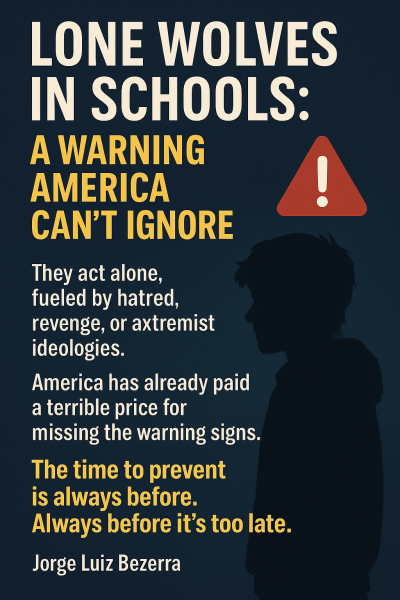Read, Comment, Share…
Lone Wolves in Schools
Condensed and adapted by Two Flags Post – Based on the original article. by Jorge Luiz Bezerra
They are not part of terrorist cells. They don’t operate under any organization’s flag. They act alone, driven by hate, revenge, or extremist ideologies. Known as “lone wolves,” these individuals can turn an ordinary school day into a national tragedy.
From Columbine to Sandy Hook, from Parkland to Uvalde, the United States knows the devastating reality of school attacks carried out by isolated individuals. The heartbreaking common thread? Most of these tragedies were preceded by clear warning signs—ignored, misunderstood, or minimized.
Agencies like the FBI, Department of Homeland Security, and international bodies like INTERPOL and EUROPOLhave documented how these attackers follow a disturbing, predictable trajectory. Research from experts such as Steve Hewitt, Bruce Hoffman, Marc Sageman, Randy Borum, and J. Reid Meloy confirms: before the first shot is fired, there are always behavioral red flags.
It begins with isolation. Then comes fascination with weapons, hate speech online, obsession with previous mass shooters, and changes in appearance or behavior. Social media posts, disturbing drawings, or sudden withdrawal from friends and family are never just “teenage phases” when seen in this context.
Hewitt’s One-man War and Just Watch Us highlight how public safety agencies often focus surveillance on politically popular targets, while missing lone actors showing clear potential for violence. Hoffman, in Inside Terrorism, details how nearly every lone-wolf attacker displayed disturbing behaviors beforehand. Sageman and Borum developed models for understanding radicalization, while Meloy mapped the “Pathway to Violence”—a dangerous escalation from thought to action.
But spotting the signs is just the first step. What matters most is the response.
In schools, administrators, teachers, counselors, and even fellow students must feel empowered—and obligated—to report concerning behavior. Parents need to engage without fear of stigmatizing their child. Mental health professionals should act quickly and thoroughly. Law enforcement, especially School Resource Officers and specialized threat assessment units, must investigate digital footprints, weapons access, and behavioral history.
Yet all this must happen with responsibility and discretion. Protecting a potential threat must never mean publicly labeling or exposing a student or family. The goal is prevention—not punishment or humiliation.
America has already paid a terrible price for ignoring the signs. The solution is not panic, but a proactive, humane, and multidisciplinary approach.
Recognize the risk. Act on the signs. Save lives.
The time to prevent is always before. Always before it’s too late.


